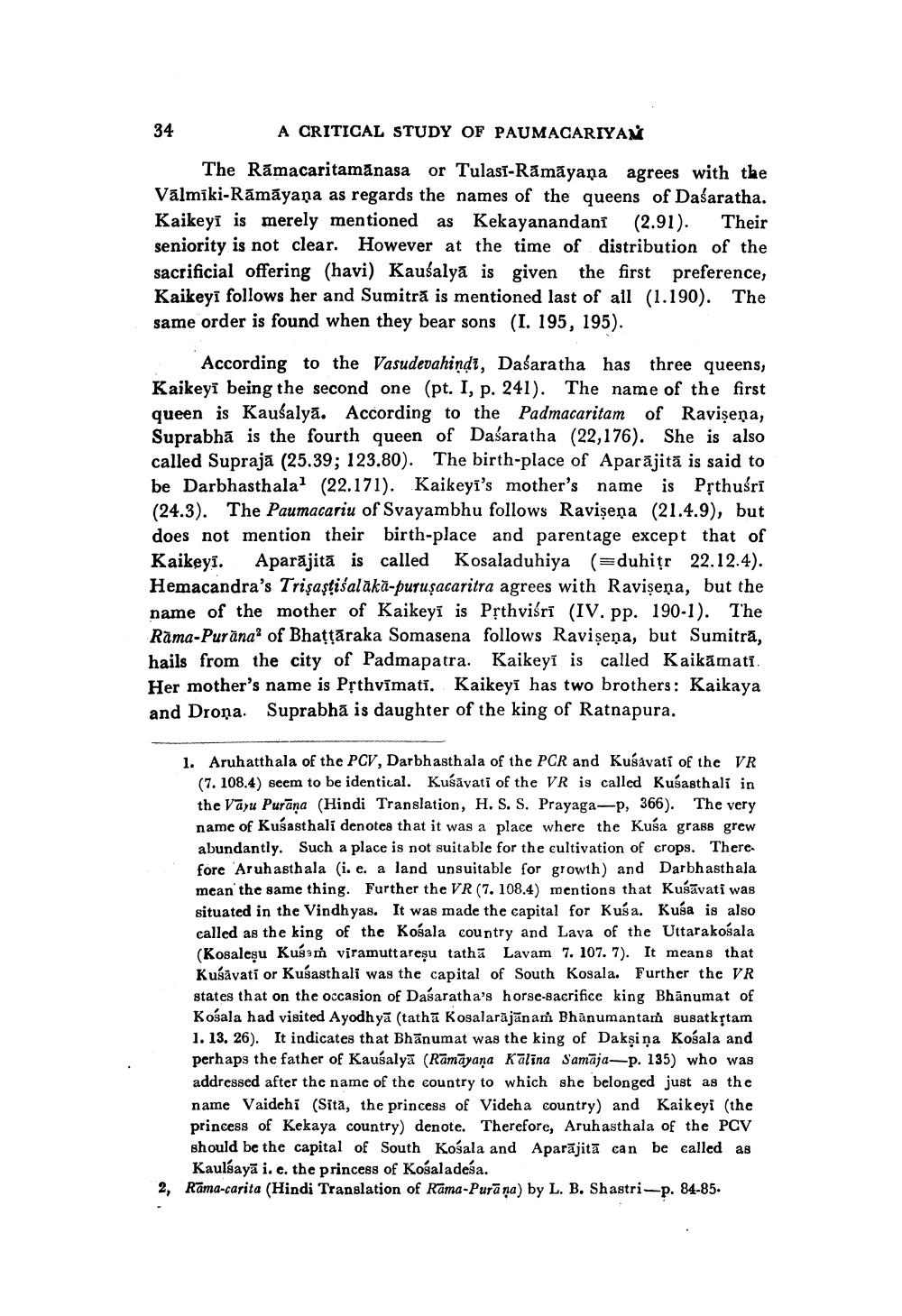________________
34
A CRITICAL STUDY OF PAUMACARIYAN
The Ramacaritamanasa or Tulasi-Rāmāyana agrees with the Vālmīki-Rāmāyaṇa as regards the names of the queens of Dasaratha. Kaikeyi is merely mentioned as Kekayanandani (2.91). Their seniority is not clear. However at the time of distribution of the sacrificial offering (havi) Kausalya is given the first preference, Kaikeyi follows her and Sumitră is mentioned last of all (1.190). The same order is found when they bear sons (I. 195, 195).
According to the Vasudevahindi, Dasaratha has three queens, Kaikeyi being the second one (pt. I, p. 241). The name of the first queen is Kausalyā. According to the Padmacaritam of Ravişeņa, Suprabhā is the fourth queen of Dasaratha (22,176). She is also called Supraja (25.39; 123.80). The birth-place of Aparājită is said to be Darbhasthalat (22.171). Kaikeyi's mother's name is Pythuśrī (24.3). The Paumacariu of Svayambhu follows Ravişeņa (21.4.9), but does not mention their birth-place and parentage except that of Kaikeyi. Aparăjită is called Kosaladuhiya (=duhiţr 22.12.4). Hemacandra's Trişaştiśalākā-puruşacaritra agrees with Ravişeņa, but the name of the mother of Kaikeyi is Pộthviếri (IV. pp. 190-1). The Rama-Purānaof Bhattāraka Somasena follows Ravişeņa, but Sumitrā, hails from the city of Padmapatra. Kaikeyi is called Kaikāmatí. Her mother's name is Pșthvimati. Kaikeyi has two brothers: Kaikaya and Drona. Suprabha is daughter of the king of Ratnapura.
1. Aruhatthala of the PCV, Darbhasth ala of the PCR and Kusávati of the VR
(7. 108.4) seem to be identical. Kuśāvati of the VR is called Kusasthali in the Vayu Purana (Hindi Translation, H. S. S. Prayaga-p, 366). The very name of Kuśasthali denotes that it was a place where the Kusa grass grew abundantly. Such a place is not suitable for the cultivation of crops. There fore Aruh asth ala (i. e. a land unsuitable for growth) and Darbhasthala mean the same thing. Further the VR (7. 108.4) mentions that Kusavati was situated in the Vindhyas. It was made the capital for Kusa. Kusa is also called as the king of the Kosala country and Lava of the Uttarakośala (Kosaleşu Kusam viramuttareșu tathā Lavam 7. 107. 7). It means that Kušavati or Kusasthali was the capital of South Kosala. Further the VR states that on the occasion of Dasaratha's horse-sacrifice king Bhānumat of Košala had visited Ayodhyā (tatha Kosalarājānam Bhanumantam susatkstam 1. 13. 26). It indicates that Bhānumat was the king of Dakşiņa Kosala and perhaps the father of Kausalyā (Rāmāyaṇa Kalina Samāja-p. 135) who was addressed after the name of the country to which she belonged just as the name Vaidehi (Sita, the princess of Videh a country) and Kaikeyi (the princess of Kekaya country) denote. Therefore, Aruhasthala of the PCV should be the capital of South Kośala and Aparājitā can be called as
Kaulsayā i. c. the princess of Kosaladesa. 2, Rāma-carita (Hindi Translation of Rama-Purā na) by L. B. Shastri-p. 84-85.




